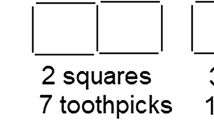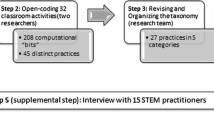Abstract
After a brief outline of the topic of non-language thinking in mathematics the central phenomenological tool in this concern is established, i.e. the eidetic method. The special form of eidetic method in mathematical proving is implicit variation and this procedure entails three rules that are established in a simple geometrical example. Then the difficulties and the merits of analogical thinking in mathematics are discussed in different aspects. On the background of a new phenomenological understanding of the performance of non-language thinking in mathematics the well-known theses of B. L. van der Waerden that mathematical thinking to a great extent proceeds without the use of language is discussed in a new light.
Similar content being viewed by others
Notes
For a more detailed argumentation in this regard especially concerning the use of implicit variation in formal mathematics, cf. Lohmar (2010).
We have to keep in mind that in this context Husserl already presupposes the kind of idealization, which differentiates the real drawing on the paper from the idealized object intended by this drawing.
It is important to remember that Husserl’s concept of apriori cannot be identified with Kant‘s concept of apriori. Cf. the important note in Husserl (1974), 255, Anm. (1). Kant regards knowledge as apriori if it can be reached independently from all experience and if it is valid before all experience.
“And that because neither the right angle, nor the equality, nor determinate length of the sides are at all concerned in the demonstration.” Berkeley (1901), Introduction, § 16.
Cf. Hume (1888), Book I, Part 1, Sec. 7.
Van der Waerden writes: „wenn man die Kurve durchläuft, kommt man zweimal durch denselben Punkt in verschiedener Richtung“ (van der Waerden (1954), 167).
They name „eigentlich Gleichzeitigkeit, räumliches Zusammenfallen, räumliche Herkunft, Zweck oder Ähnlichkeit“ (van der Waerden (1954), 168).
Cf. van der Waerden (1954), 168.
Cf. van der Waerden (1954), 170.
Cf. van der Waerden (1954), 171.
Van der Waerden writes: „Denken ohne Sprache [ist] möglich, aber die Sprache erleichtert das Denken und schafft neue Objekte für das Denken.“ (van der Waerden (1954), 172) and „für das Denken spielt die Art der Vorstellungen, mit denen es arbeitet, nur eine sehr untergeordnete Rolle“ (van der Waerden (1954), 172).
References
Berkeley G (1901) A treatise concerning the principles of human knowledge. In: Fraser AC (ed) The works of George Berkeley, vol. 1. Oxford University Press, Oxford
Hume D (1888) In: Selby-Bigge LA (ed) A treatise of human nature. Oxford University Press, Oxford
Husserl E (1974) Formale und transzendentale Logik. (Husserliana vol. XVII). Nijhoff, Den Haag 1974
Husserl E (1976) Ideen zu einer reine Phänomenologie und phänomenologischen Philosophie. Erstes Buch. Allgemeine Einführung in die reine Phänomenologie. Text der 1.-3. Auflage. Hrsg. K. Schuhmann. (Husserliana III/1). Nijhof, Den Haag
Lohmar D (1989) Phänomenologie der Mathematik. Phaenomenologica 114. Kluwer Publishers, Dordrecht
Lohmar D (2002) Husserl’s concept of categorical intuition. In: Zahavi D, Stjernfelt F (eds) Hundred years of phenomenology. Kluwer Publishers, Dordrecht. pp 125–145
Lohmar D (2010) Intuition in mathematics. On the function of eidetic variation in mathematical proofs. In: Haaparantha L, Hartimo M (eds) Phenomenology and mathematics. Springer, Heidelberg
van der Waerden BL (1954a) Denken ohne Sprache. In: Révész G (ed) Symposium thinking and speaking. Published in: Acta Psychologica, Amsterdam, 10 (1954), 165–174
van der Waerden BL (1954/1955) Einfall und Überlegung in der Mathematik I, In: Elem. Math. 8 (1954), 121–129, Einfall und Überlegung in der Mathematik II, III, in: Elem. Math. 9 (1955), 1–9 and 49–56
Author information
Authors and Affiliations
Corresponding author
Rights and permissions
About this article
Cite this article
Lohmar, D. Non-Language Thinking in Mathematics. Axiomathes 22, 109–120 (2012). https://doi.org/10.1007/s10516-011-9164-x
Received:
Accepted:
Published:
Issue Date:
DOI: https://doi.org/10.1007/s10516-011-9164-x




